Business and Business Environment: Tesco and Sainsbury's Analysis
VerifiedAdded on 2023/01/06
|14
|4214
|93
Report
AI Summary
This report provides a comprehensive analysis of Tesco's business environment, encompassing various organizational aspects. It begins with an introduction to business environments and then delves into the types, sizes, and scopes of organizations, exploring public, private, and voluntary sectors, along with micro, small, and medium enterprises. The report examines the interrelationships between different organizational functions, such as finance, marketing, production, and human resources, and their impact on achieving organizational objectives. It also describes different organizational structures like hierarchical, functional, divisional, and matrix structures, with a specific focus on Tesco's hierarchical functional structure. The report then conducts a PESTLE analysis of Tesco, evaluating the impact of political, economic, social, technological, legal, and environmental factors on its operations. Furthermore, a SWOT analysis is performed, comparing Tesco and Sainsbury's, and analyzing the interrelationship between macro environment factors and their strengths and weaknesses. The report concludes with a summary of the key findings and insights.
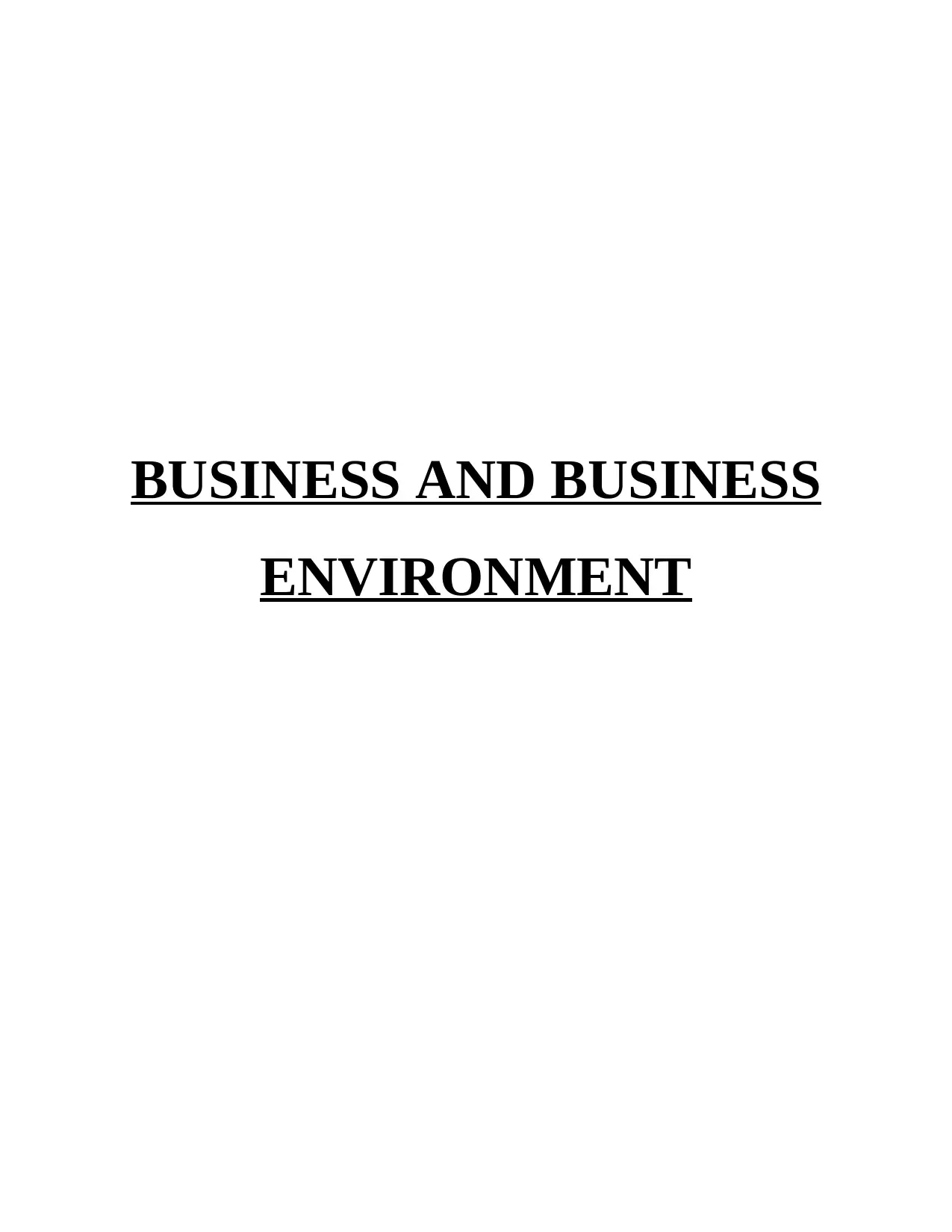
BUSINESS AND BUSINESS
ENVIRONMENT
ENVIRONMENT
Paraphrase This Document
Need a fresh take? Get an instant paraphrase of this document with our AI Paraphraser
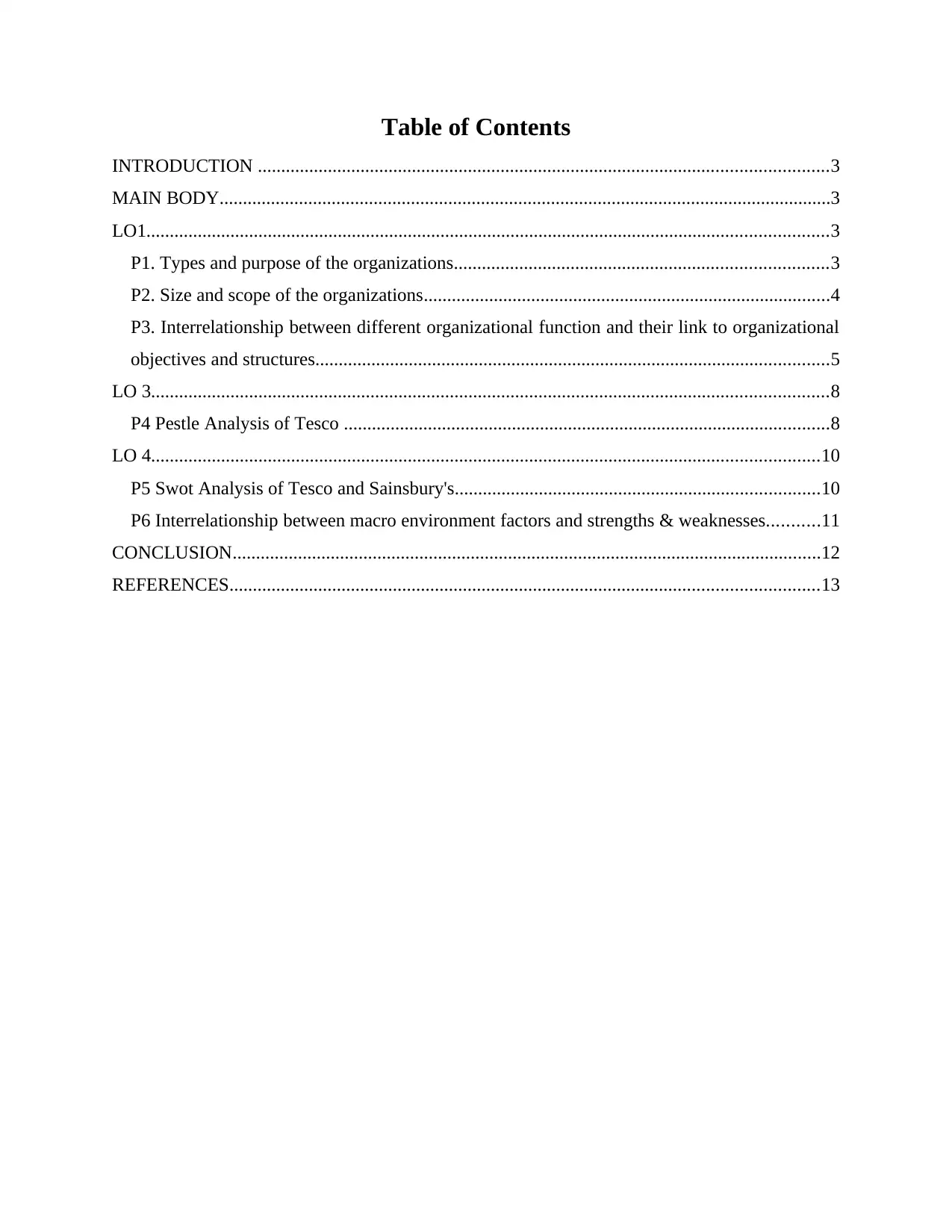
Table of Contents
INTRODUCTION ..........................................................................................................................3
MAIN BODY...................................................................................................................................3
LO1..................................................................................................................................................3
P1. Types and purpose of the organizations................................................................................3
P2. Size and scope of the organizations.......................................................................................4
P3. Interrelationship between different organizational function and their link to organizational
objectives and structures..............................................................................................................5
LO 3.................................................................................................................................................8
P4 Pestle Analysis of Tesco ........................................................................................................8
LO 4...............................................................................................................................................10
P5 Swot Analysis of Tesco and Sainsbury's..............................................................................10
P6 Interrelationship between macro environment factors and strengths & weaknesses...........11
CONCLUSION..............................................................................................................................12
REFERENCES..............................................................................................................................13
INTRODUCTION ..........................................................................................................................3
MAIN BODY...................................................................................................................................3
LO1..................................................................................................................................................3
P1. Types and purpose of the organizations................................................................................3
P2. Size and scope of the organizations.......................................................................................4
P3. Interrelationship between different organizational function and their link to organizational
objectives and structures..............................................................................................................5
LO 3.................................................................................................................................................8
P4 Pestle Analysis of Tesco ........................................................................................................8
LO 4...............................................................................................................................................10
P5 Swot Analysis of Tesco and Sainsbury's..............................................................................10
P6 Interrelationship between macro environment factors and strengths & weaknesses...........11
CONCLUSION..............................................................................................................................12
REFERENCES..............................................................................................................................13

⊘ This is a preview!⊘
Do you want full access?
Subscribe today to unlock all pages.

Trusted by 1+ million students worldwide
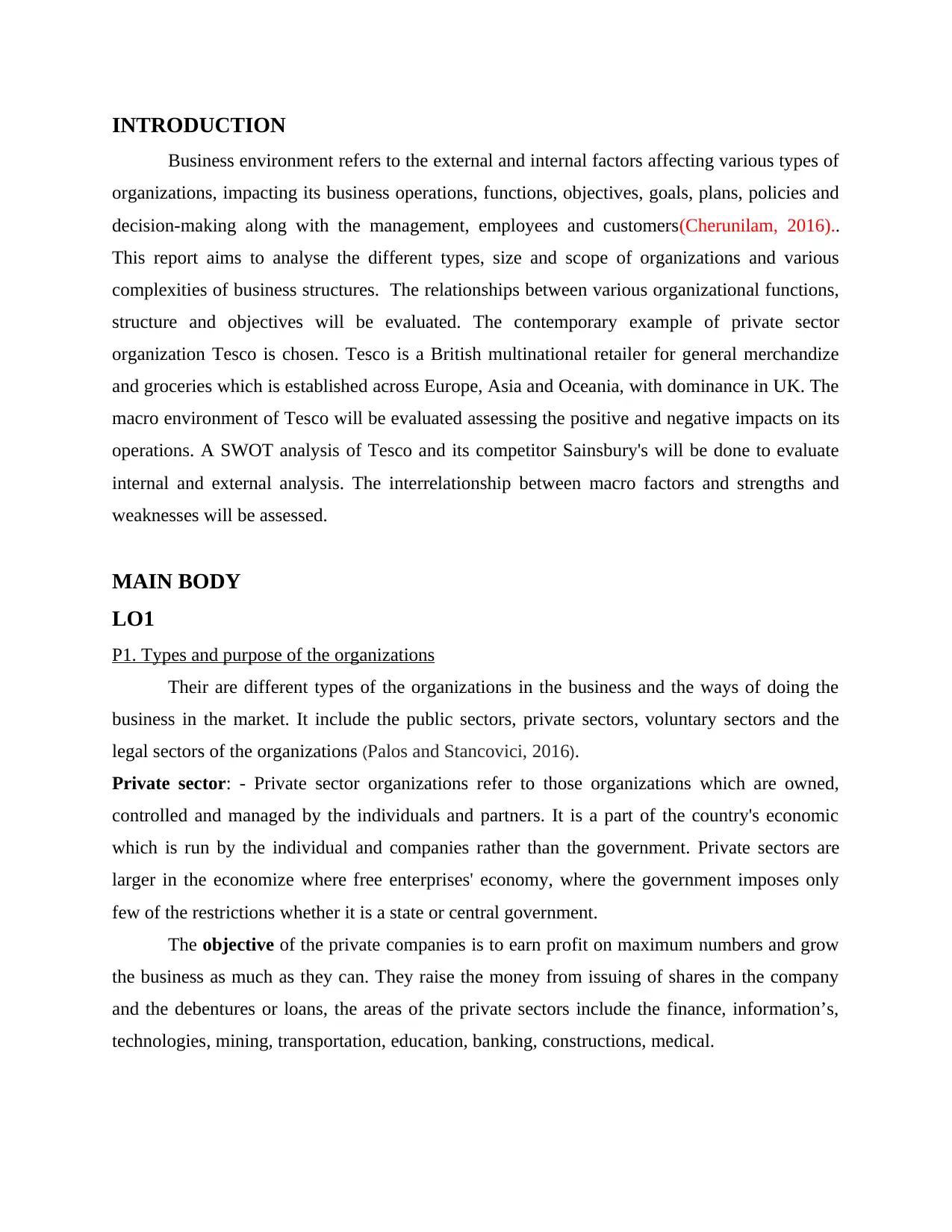
INTRODUCTION
Business environment refers to the external and internal factors affecting various types of
organizations, impacting its business operations, functions, objectives, goals, plans, policies and
decision-making along with the management, employees and customers(Cherunilam, 2016)..
This report aims to analyse the different types, size and scope of organizations and various
complexities of business structures. The relationships between various organizational functions,
structure and objectives will be evaluated. The contemporary example of private sector
organization Tesco is chosen. Tesco is a British multinational retailer for general merchandize
and groceries which is established across Europe, Asia and Oceania, with dominance in UK. The
macro environment of Tesco will be evaluated assessing the positive and negative impacts on its
operations. A SWOT analysis of Tesco and its competitor Sainsbury's will be done to evaluate
internal and external analysis. The interrelationship between macro factors and strengths and
weaknesses will be assessed.
MAIN BODY
LO1
P1. Types and purpose of the organizations
Their are different types of the organizations in the business and the ways of doing the
business in the market. It include the public sectors, private sectors, voluntary sectors and the
legal sectors of the organizations (Palos and Stancovici, 2016).
Private sector: - Private sector organizations refer to those organizations which are owned,
controlled and managed by the individuals and partners. It is a part of the country's economic
which is run by the individual and companies rather than the government. Private sectors are
larger in the economize where free enterprises' economy, where the government imposes only
few of the restrictions whether it is a state or central government.
The objective of the private companies is to earn profit on maximum numbers and grow
the business as much as they can. They raise the money from issuing of shares in the company
and the debentures or loans, the areas of the private sectors include the finance, information’s,
technologies, mining, transportation, education, banking, constructions, medical.
Business environment refers to the external and internal factors affecting various types of
organizations, impacting its business operations, functions, objectives, goals, plans, policies and
decision-making along with the management, employees and customers(Cherunilam, 2016)..
This report aims to analyse the different types, size and scope of organizations and various
complexities of business structures. The relationships between various organizational functions,
structure and objectives will be evaluated. The contemporary example of private sector
organization Tesco is chosen. Tesco is a British multinational retailer for general merchandize
and groceries which is established across Europe, Asia and Oceania, with dominance in UK. The
macro environment of Tesco will be evaluated assessing the positive and negative impacts on its
operations. A SWOT analysis of Tesco and its competitor Sainsbury's will be done to evaluate
internal and external analysis. The interrelationship between macro factors and strengths and
weaknesses will be assessed.
MAIN BODY
LO1
P1. Types and purpose of the organizations
Their are different types of the organizations in the business and the ways of doing the
business in the market. It include the public sectors, private sectors, voluntary sectors and the
legal sectors of the organizations (Palos and Stancovici, 2016).
Private sector: - Private sector organizations refer to those organizations which are owned,
controlled and managed by the individuals and partners. It is a part of the country's economic
which is run by the individual and companies rather than the government. Private sectors are
larger in the economize where free enterprises' economy, where the government imposes only
few of the restrictions whether it is a state or central government.
The objective of the private companies is to earn profit on maximum numbers and grow
the business as much as they can. They raise the money from issuing of shares in the company
and the debentures or loans, the areas of the private sectors include the finance, information’s,
technologies, mining, transportation, education, banking, constructions, medical.
Paraphrase This Document
Need a fresh take? Get an instant paraphrase of this document with our AI Paraphraser
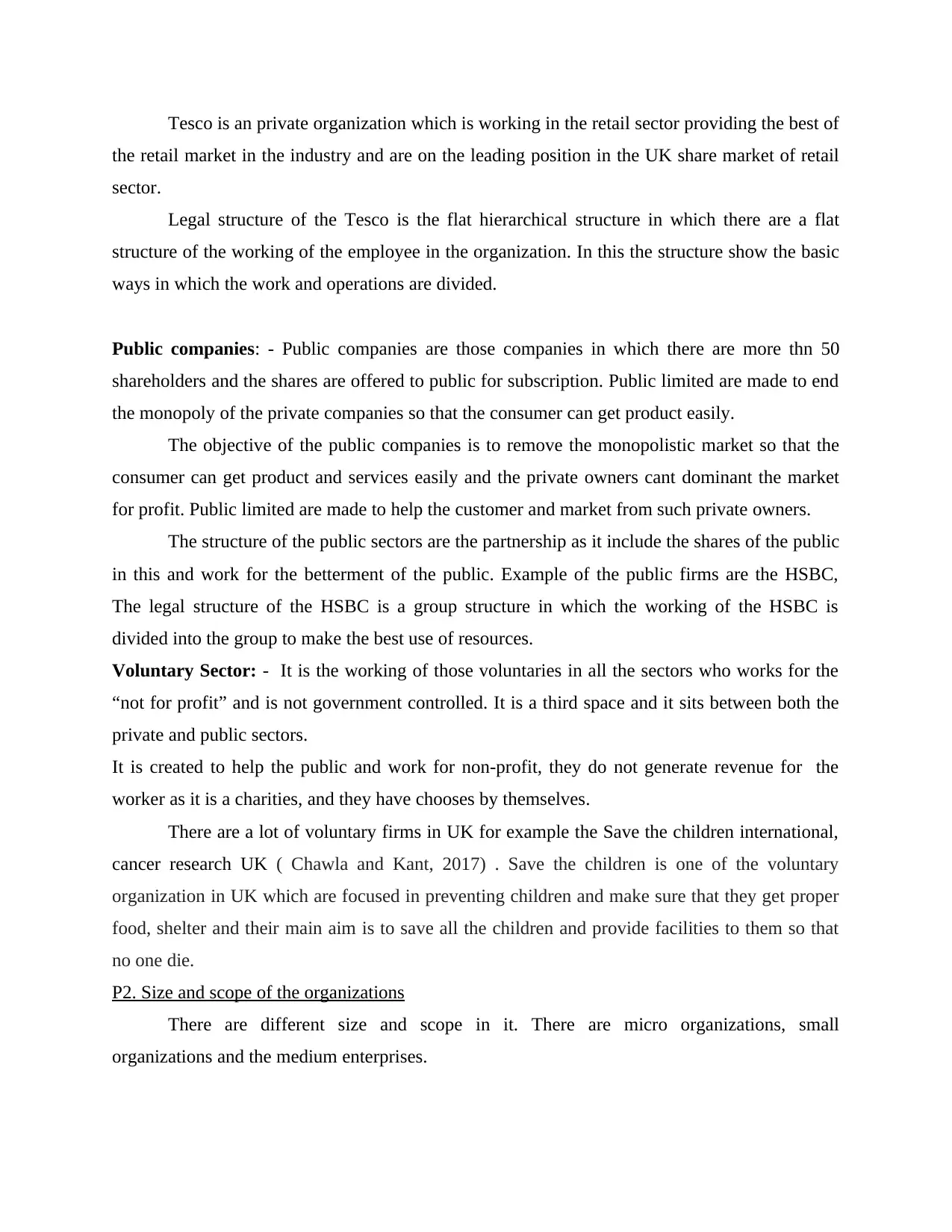
Tesco is an private organization which is working in the retail sector providing the best of
the retail market in the industry and are on the leading position in the UK share market of retail
sector.
Legal structure of the Tesco is the flat hierarchical structure in which there are a flat
structure of the working of the employee in the organization. In this the structure show the basic
ways in which the work and operations are divided.
Public companies: - Public companies are those companies in which there are more thn 50
shareholders and the shares are offered to public for subscription. Public limited are made to end
the monopoly of the private companies so that the consumer can get product easily.
The objective of the public companies is to remove the monopolistic market so that the
consumer can get product and services easily and the private owners cant dominant the market
for profit. Public limited are made to help the customer and market from such private owners.
The structure of the public sectors are the partnership as it include the shares of the public
in this and work for the betterment of the public. Example of the public firms are the HSBC,
The legal structure of the HSBC is a group structure in which the working of the HSBC is
divided into the group to make the best use of resources.
Voluntary Sector: - It is the working of those voluntaries in all the sectors who works for the
“not for profit” and is not government controlled. It is a third space and it sits between both the
private and public sectors.
It is created to help the public and work for non-profit, they do not generate revenue for the
worker as it is a charities, and they have chooses by themselves.
There are a lot of voluntary firms in UK for example the Save the children international,
cancer research UK ( Chawla and Kant, 2017) . Save the children is one of the voluntary
organization in UK which are focused in preventing children and make sure that they get proper
food, shelter and their main aim is to save all the children and provide facilities to them so that
no one die.
P2. Size and scope of the organizations
There are different size and scope in it. There are micro organizations, small
organizations and the medium enterprises.
the retail market in the industry and are on the leading position in the UK share market of retail
sector.
Legal structure of the Tesco is the flat hierarchical structure in which there are a flat
structure of the working of the employee in the organization. In this the structure show the basic
ways in which the work and operations are divided.
Public companies: - Public companies are those companies in which there are more thn 50
shareholders and the shares are offered to public for subscription. Public limited are made to end
the monopoly of the private companies so that the consumer can get product easily.
The objective of the public companies is to remove the monopolistic market so that the
consumer can get product and services easily and the private owners cant dominant the market
for profit. Public limited are made to help the customer and market from such private owners.
The structure of the public sectors are the partnership as it include the shares of the public
in this and work for the betterment of the public. Example of the public firms are the HSBC,
The legal structure of the HSBC is a group structure in which the working of the HSBC is
divided into the group to make the best use of resources.
Voluntary Sector: - It is the working of those voluntaries in all the sectors who works for the
“not for profit” and is not government controlled. It is a third space and it sits between both the
private and public sectors.
It is created to help the public and work for non-profit, they do not generate revenue for the
worker as it is a charities, and they have chooses by themselves.
There are a lot of voluntary firms in UK for example the Save the children international,
cancer research UK ( Chawla and Kant, 2017) . Save the children is one of the voluntary
organization in UK which are focused in preventing children and make sure that they get proper
food, shelter and their main aim is to save all the children and provide facilities to them so that
no one die.
P2. Size and scope of the organizations
There are different size and scope in it. There are micro organizations, small
organizations and the medium enterprises.
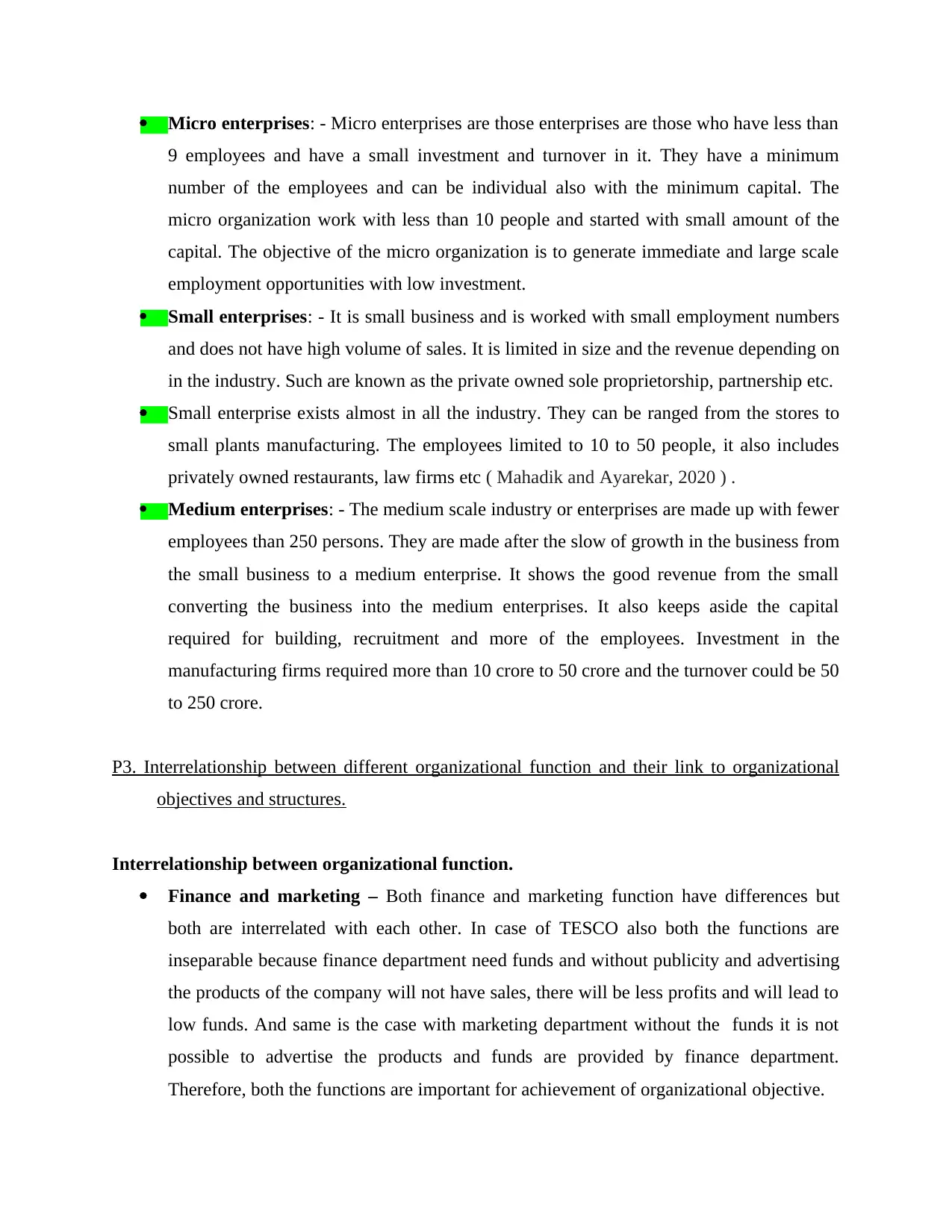
Micro enterprises: - Micro enterprises are those enterprises are those who have less than
9 employees and have a small investment and turnover in it. They have a minimum
number of the employees and can be individual also with the minimum capital. The
micro organization work with less than 10 people and started with small amount of the
capital. The objective of the micro organization is to generate immediate and large scale
employment opportunities with low investment.
Small enterprises: - It is small business and is worked with small employment numbers
and does not have high volume of sales. It is limited in size and the revenue depending on
in the industry. Such are known as the private owned sole proprietorship, partnership etc.
Small enterprise exists almost in all the industry. They can be ranged from the stores to
small plants manufacturing. The employees limited to 10 to 50 people, it also includes
privately owned restaurants, law firms etc ( Mahadik and Ayarekar, 2020 ) .
Medium enterprises: - The medium scale industry or enterprises are made up with fewer
employees than 250 persons. They are made after the slow of growth in the business from
the small business to a medium enterprise. It shows the good revenue from the small
converting the business into the medium enterprises. It also keeps aside the capital
required for building, recruitment and more of the employees. Investment in the
manufacturing firms required more than 10 crore to 50 crore and the turnover could be 50
to 250 crore.
P3. Interrelationship between different organizational function and their link to organizational
objectives and structures.
Interrelationship between organizational function.
Finance and marketing – Both finance and marketing function have differences but
both are interrelated with each other. In case of TESCO also both the functions are
inseparable because finance department need funds and without publicity and advertising
the products of the company will not have sales, there will be less profits and will lead to
low funds. And same is the case with marketing department without the funds it is not
possible to advertise the products and funds are provided by finance department.
Therefore, both the functions are important for achievement of organizational objective.
9 employees and have a small investment and turnover in it. They have a minimum
number of the employees and can be individual also with the minimum capital. The
micro organization work with less than 10 people and started with small amount of the
capital. The objective of the micro organization is to generate immediate and large scale
employment opportunities with low investment.
Small enterprises: - It is small business and is worked with small employment numbers
and does not have high volume of sales. It is limited in size and the revenue depending on
in the industry. Such are known as the private owned sole proprietorship, partnership etc.
Small enterprise exists almost in all the industry. They can be ranged from the stores to
small plants manufacturing. The employees limited to 10 to 50 people, it also includes
privately owned restaurants, law firms etc ( Mahadik and Ayarekar, 2020 ) .
Medium enterprises: - The medium scale industry or enterprises are made up with fewer
employees than 250 persons. They are made after the slow of growth in the business from
the small business to a medium enterprise. It shows the good revenue from the small
converting the business into the medium enterprises. It also keeps aside the capital
required for building, recruitment and more of the employees. Investment in the
manufacturing firms required more than 10 crore to 50 crore and the turnover could be 50
to 250 crore.
P3. Interrelationship between different organizational function and their link to organizational
objectives and structures.
Interrelationship between organizational function.
Finance and marketing – Both finance and marketing function have differences but
both are interrelated with each other. In case of TESCO also both the functions are
inseparable because finance department need funds and without publicity and advertising
the products of the company will not have sales, there will be less profits and will lead to
low funds. And same is the case with marketing department without the funds it is not
possible to advertise the products and funds are provided by finance department.
Therefore, both the functions are important for achievement of organizational objective.
⊘ This is a preview!⊘
Do you want full access?
Subscribe today to unlock all pages.

Trusted by 1+ million students worldwide
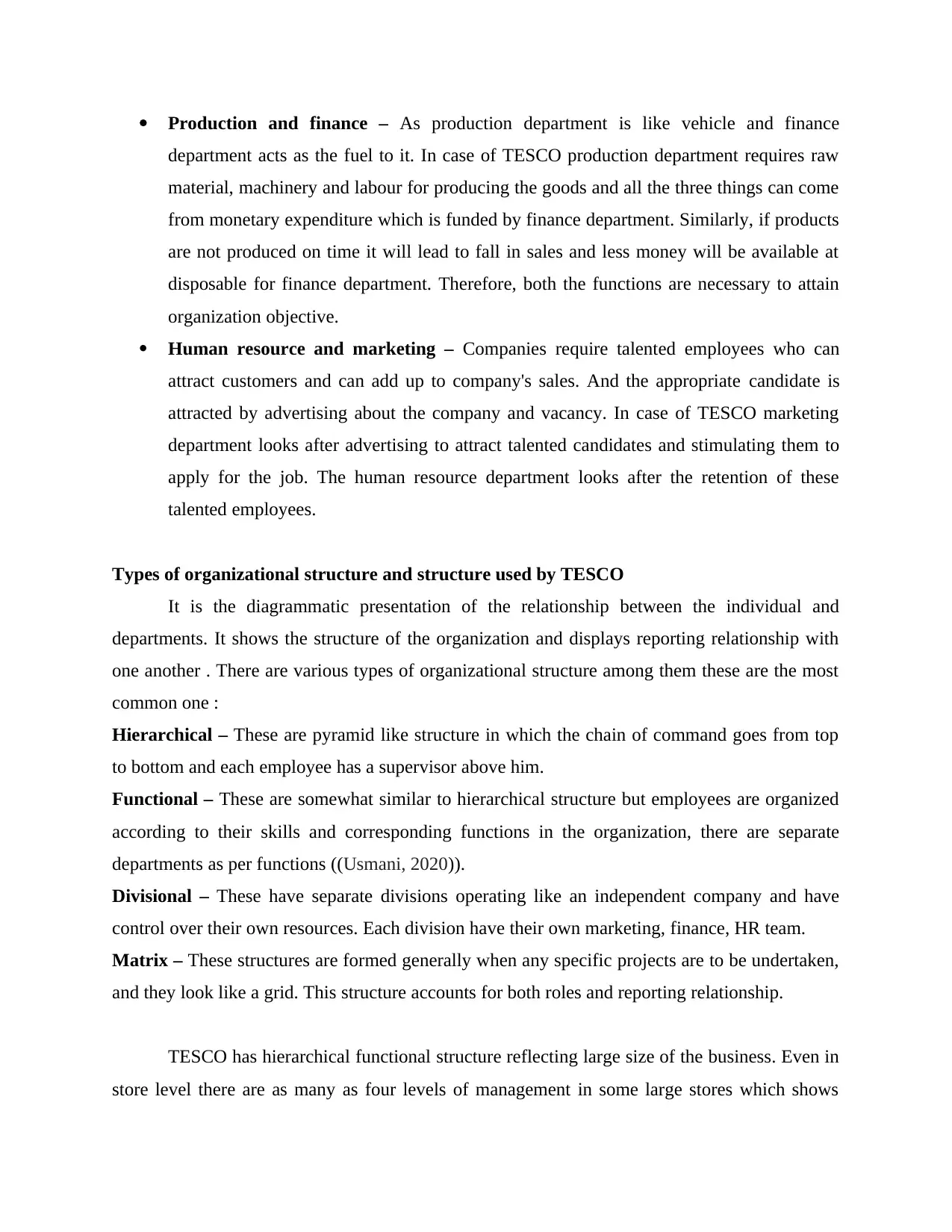
Production and finance – As production department is like vehicle and finance
department acts as the fuel to it. In case of TESCO production department requires raw
material, machinery and labour for producing the goods and all the three things can come
from monetary expenditure which is funded by finance department. Similarly, if products
are not produced on time it will lead to fall in sales and less money will be available at
disposable for finance department. Therefore, both the functions are necessary to attain
organization objective.
Human resource and marketing – Companies require talented employees who can
attract customers and can add up to company's sales. And the appropriate candidate is
attracted by advertising about the company and vacancy. In case of TESCO marketing
department looks after advertising to attract talented candidates and stimulating them to
apply for the job. The human resource department looks after the retention of these
talented employees.
Types of organizational structure and structure used by TESCO
It is the diagrammatic presentation of the relationship between the individual and
departments. It shows the structure of the organization and displays reporting relationship with
one another . There are various types of organizational structure among them these are the most
common one :
Hierarchical – These are pyramid like structure in which the chain of command goes from top
to bottom and each employee has a supervisor above him.
Functional – These are somewhat similar to hierarchical structure but employees are organized
according to their skills and corresponding functions in the organization, there are separate
departments as per functions ((Usmani, 2020)).
Divisional – These have separate divisions operating like an independent company and have
control over their own resources. Each division have their own marketing, finance, HR team.
Matrix – These structures are formed generally when any specific projects are to be undertaken,
and they look like a grid. This structure accounts for both roles and reporting relationship.
TESCO has hierarchical functional structure reflecting large size of the business. Even in
store level there are as many as four levels of management in some large stores which shows
department acts as the fuel to it. In case of TESCO production department requires raw
material, machinery and labour for producing the goods and all the three things can come
from monetary expenditure which is funded by finance department. Similarly, if products
are not produced on time it will lead to fall in sales and less money will be available at
disposable for finance department. Therefore, both the functions are necessary to attain
organization objective.
Human resource and marketing – Companies require talented employees who can
attract customers and can add up to company's sales. And the appropriate candidate is
attracted by advertising about the company and vacancy. In case of TESCO marketing
department looks after advertising to attract talented candidates and stimulating them to
apply for the job. The human resource department looks after the retention of these
talented employees.
Types of organizational structure and structure used by TESCO
It is the diagrammatic presentation of the relationship between the individual and
departments. It shows the structure of the organization and displays reporting relationship with
one another . There are various types of organizational structure among them these are the most
common one :
Hierarchical – These are pyramid like structure in which the chain of command goes from top
to bottom and each employee has a supervisor above him.
Functional – These are somewhat similar to hierarchical structure but employees are organized
according to their skills and corresponding functions in the organization, there are separate
departments as per functions ((Usmani, 2020)).
Divisional – These have separate divisions operating like an independent company and have
control over their own resources. Each division have their own marketing, finance, HR team.
Matrix – These structures are formed generally when any specific projects are to be undertaken,
and they look like a grid. This structure accounts for both roles and reporting relationship.
TESCO has hierarchical functional structure reflecting large size of the business. Even in
store level there are as many as four levels of management in some large stores which shows
Paraphrase This Document
Need a fresh take? Get an instant paraphrase of this document with our AI Paraphraser
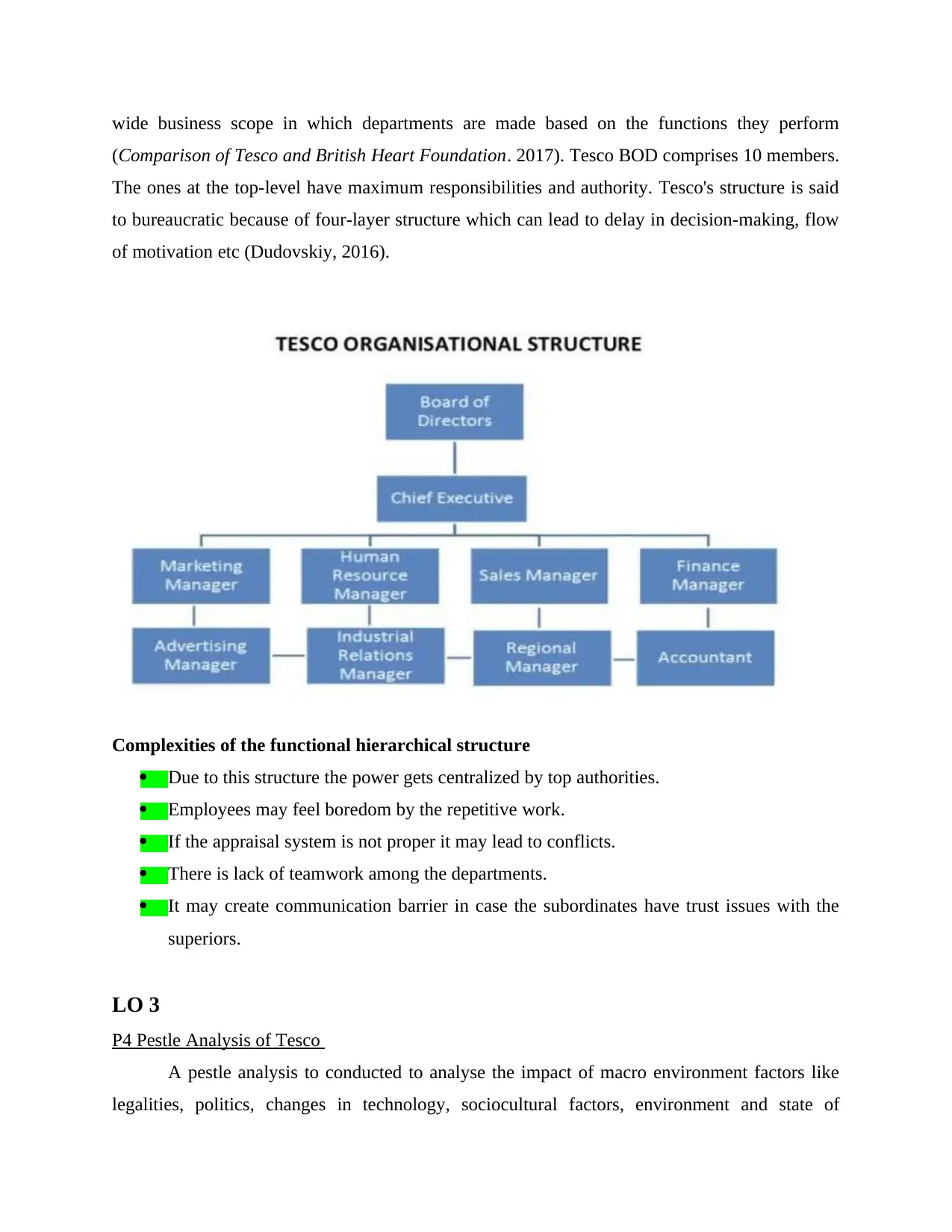
wide business scope in which departments are made based on the functions they perform
(Comparison of Tesco and British Heart Foundation. 2017). Tesco BOD comprises 10 members.
The ones at the top-level have maximum responsibilities and authority. Tesco's structure is said
to bureaucratic because of four-layer structure which can lead to delay in decision-making, flow
of motivation etc (Dudovskiy, 2016).
Complexities of the functional hierarchical structure
Due to this structure the power gets centralized by top authorities.
Employees may feel boredom by the repetitive work.
If the appraisal system is not proper it may lead to conflicts.
There is lack of teamwork among the departments.
It may create communication barrier in case the subordinates have trust issues with the
superiors.
LO 3
P4 Pestle Analysis of Tesco
A pestle analysis to conducted to analyse the impact of macro environment factors like
legalities, politics, changes in technology, sociocultural factors, environment and state of
(Comparison of Tesco and British Heart Foundation. 2017). Tesco BOD comprises 10 members.
The ones at the top-level have maximum responsibilities and authority. Tesco's structure is said
to bureaucratic because of four-layer structure which can lead to delay in decision-making, flow
of motivation etc (Dudovskiy, 2016).
Complexities of the functional hierarchical structure
Due to this structure the power gets centralized by top authorities.
Employees may feel boredom by the repetitive work.
If the appraisal system is not proper it may lead to conflicts.
There is lack of teamwork among the departments.
It may create communication barrier in case the subordinates have trust issues with the
superiors.
LO 3
P4 Pestle Analysis of Tesco
A pestle analysis to conducted to analyse the impact of macro environment factors like
legalities, politics, changes in technology, sociocultural factors, environment and state of
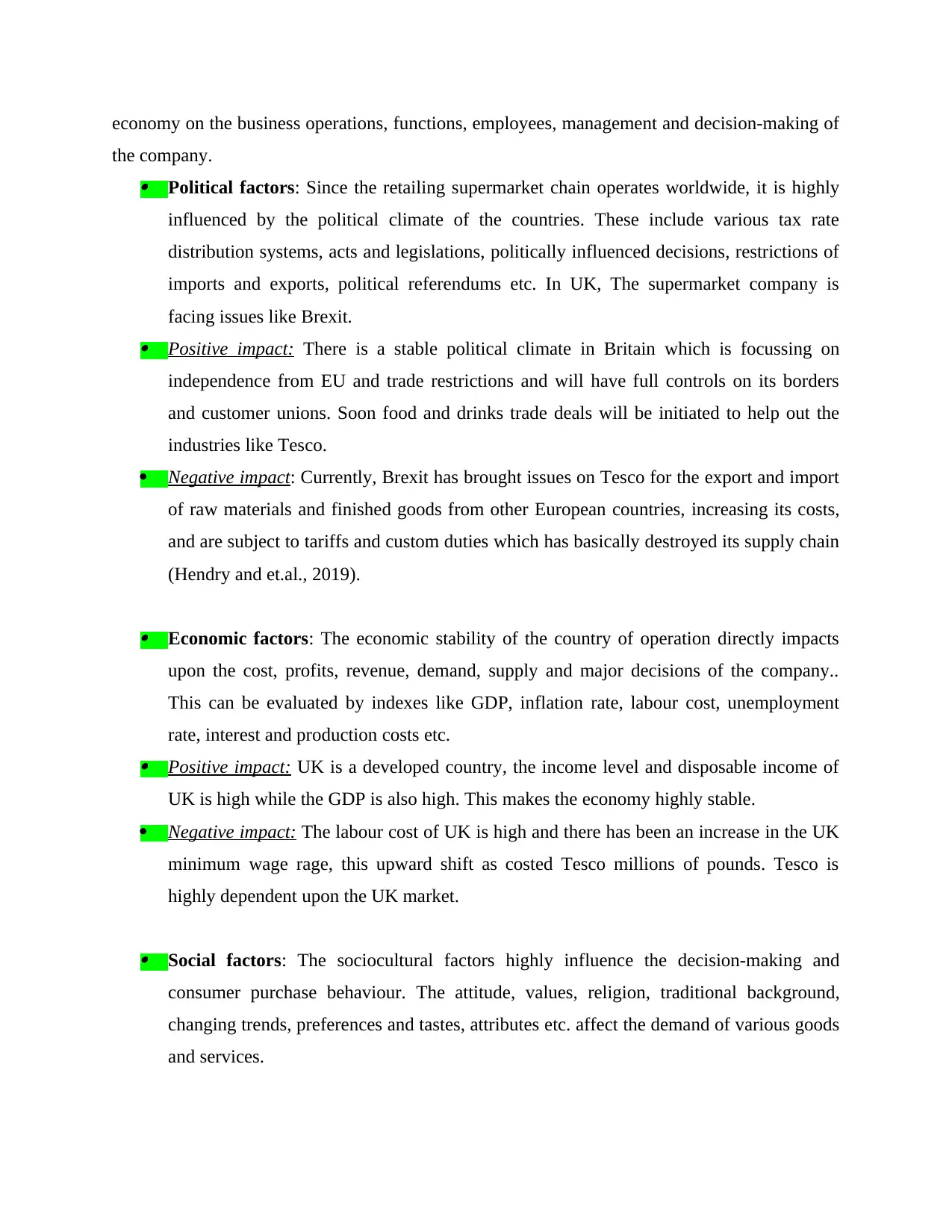
economy on the business operations, functions, employees, management and decision-making of
the company. Political factors: Since the retailing supermarket chain operates worldwide, it is highly
influenced by the political climate of the countries. These include various tax rate
distribution systems, acts and legislations, politically influenced decisions, restrictions of
imports and exports, political referendums etc. In UK, The supermarket company is
facing issues like Brexit. Positive impact: There is a stable political climate in Britain which is focussing on
independence from EU and trade restrictions and will have full controls on its borders
and customer unions. Soon food and drinks trade deals will be initiated to help out the
industries like Tesco.
Negative impact: Currently, Brexit has brought issues on Tesco for the export and import
of raw materials and finished goods from other European countries, increasing its costs,
and are subject to tariffs and custom duties which has basically destroyed its supply chain
(Hendry and et.al., 2019).
Economic factors: The economic stability of the country of operation directly impacts
upon the cost, profits, revenue, demand, supply and major decisions of the company..
This can be evaluated by indexes like GDP, inflation rate, labour cost, unemployment
rate, interest and production costs etc. Positive impact: UK is a developed country, the income level and disposable income of
UK is high while the GDP is also high. This makes the economy highly stable.
Negative impact: The labour cost of UK is high and there has been an increase in the UK
minimum wage rage, this upward shift as costed Tesco millions of pounds. Tesco is
highly dependent upon the UK market.
Social factors: The sociocultural factors highly influence the decision-making and
consumer purchase behaviour. The attitude, values, religion, traditional background,
changing trends, preferences and tastes, attributes etc. affect the demand of various goods
and services.
the company. Political factors: Since the retailing supermarket chain operates worldwide, it is highly
influenced by the political climate of the countries. These include various tax rate
distribution systems, acts and legislations, politically influenced decisions, restrictions of
imports and exports, political referendums etc. In UK, The supermarket company is
facing issues like Brexit. Positive impact: There is a stable political climate in Britain which is focussing on
independence from EU and trade restrictions and will have full controls on its borders
and customer unions. Soon food and drinks trade deals will be initiated to help out the
industries like Tesco.
Negative impact: Currently, Brexit has brought issues on Tesco for the export and import
of raw materials and finished goods from other European countries, increasing its costs,
and are subject to tariffs and custom duties which has basically destroyed its supply chain
(Hendry and et.al., 2019).
Economic factors: The economic stability of the country of operation directly impacts
upon the cost, profits, revenue, demand, supply and major decisions of the company..
This can be evaluated by indexes like GDP, inflation rate, labour cost, unemployment
rate, interest and production costs etc. Positive impact: UK is a developed country, the income level and disposable income of
UK is high while the GDP is also high. This makes the economy highly stable.
Negative impact: The labour cost of UK is high and there has been an increase in the UK
minimum wage rage, this upward shift as costed Tesco millions of pounds. Tesco is
highly dependent upon the UK market.
Social factors: The sociocultural factors highly influence the decision-making and
consumer purchase behaviour. The attitude, values, religion, traditional background,
changing trends, preferences and tastes, attributes etc. affect the demand of various goods
and services.
⊘ This is a preview!⊘
Do you want full access?
Subscribe today to unlock all pages.

Trusted by 1+ million students worldwide
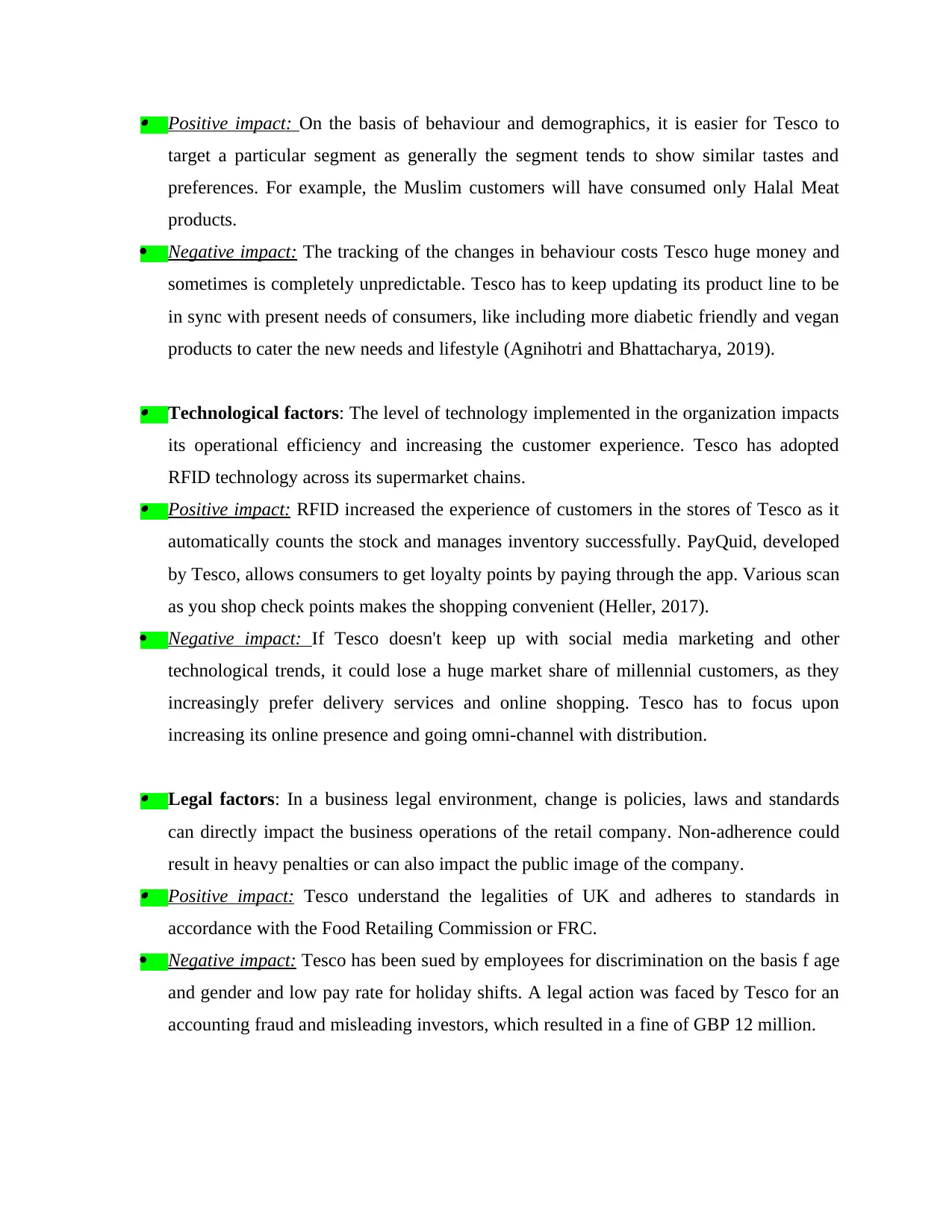
Positive impact: On the basis of behaviour and demographics, it is easier for Tesco to
target a particular segment as generally the segment tends to show similar tastes and
preferences. For example, the Muslim customers will have consumed only Halal Meat
products.
Negative impact: The tracking of the changes in behaviour costs Tesco huge money and
sometimes is completely unpredictable. Tesco has to keep updating its product line to be
in sync with present needs of consumers, like including more diabetic friendly and vegan
products to cater the new needs and lifestyle (Agnihotri and Bhattacharya, 2019).
Technological factors: The level of technology implemented in the organization impacts
its operational efficiency and increasing the customer experience. Tesco has adopted
RFID technology across its supermarket chains. Positive impact: RFID increased the experience of customers in the stores of Tesco as it
automatically counts the stock and manages inventory successfully. PayQuid, developed
by Tesco, allows consumers to get loyalty points by paying through the app. Various scan
as you shop check points makes the shopping convenient (Heller, 2017).
Negative impact: If Tesco doesn't keep up with social media marketing and other
technological trends, it could lose a huge market share of millennial customers, as they
increasingly prefer delivery services and online shopping. Tesco has to focus upon
increasing its online presence and going omni-channel with distribution.
Legal factors: In a business legal environment, change is policies, laws and standards
can directly impact the business operations of the retail company. Non-adherence could
result in heavy penalties or can also impact the public image of the company. Positive impact: Tesco understand the legalities of UK and adheres to standards in
accordance with the Food Retailing Commission or FRC.
Negative impact: Tesco has been sued by employees for discrimination on the basis f age
and gender and low pay rate for holiday shifts. A legal action was faced by Tesco for an
accounting fraud and misleading investors, which resulted in a fine of GBP 12 million.
target a particular segment as generally the segment tends to show similar tastes and
preferences. For example, the Muslim customers will have consumed only Halal Meat
products.
Negative impact: The tracking of the changes in behaviour costs Tesco huge money and
sometimes is completely unpredictable. Tesco has to keep updating its product line to be
in sync with present needs of consumers, like including more diabetic friendly and vegan
products to cater the new needs and lifestyle (Agnihotri and Bhattacharya, 2019).
Technological factors: The level of technology implemented in the organization impacts
its operational efficiency and increasing the customer experience. Tesco has adopted
RFID technology across its supermarket chains. Positive impact: RFID increased the experience of customers in the stores of Tesco as it
automatically counts the stock and manages inventory successfully. PayQuid, developed
by Tesco, allows consumers to get loyalty points by paying through the app. Various scan
as you shop check points makes the shopping convenient (Heller, 2017).
Negative impact: If Tesco doesn't keep up with social media marketing and other
technological trends, it could lose a huge market share of millennial customers, as they
increasingly prefer delivery services and online shopping. Tesco has to focus upon
increasing its online presence and going omni-channel with distribution.
Legal factors: In a business legal environment, change is policies, laws and standards
can directly impact the business operations of the retail company. Non-adherence could
result in heavy penalties or can also impact the public image of the company. Positive impact: Tesco understand the legalities of UK and adheres to standards in
accordance with the Food Retailing Commission or FRC.
Negative impact: Tesco has been sued by employees for discrimination on the basis f age
and gender and low pay rate for holiday shifts. A legal action was faced by Tesco for an
accounting fraud and misleading investors, which resulted in a fine of GBP 12 million.
Paraphrase This Document
Need a fresh take? Get an instant paraphrase of this document with our AI Paraphraser
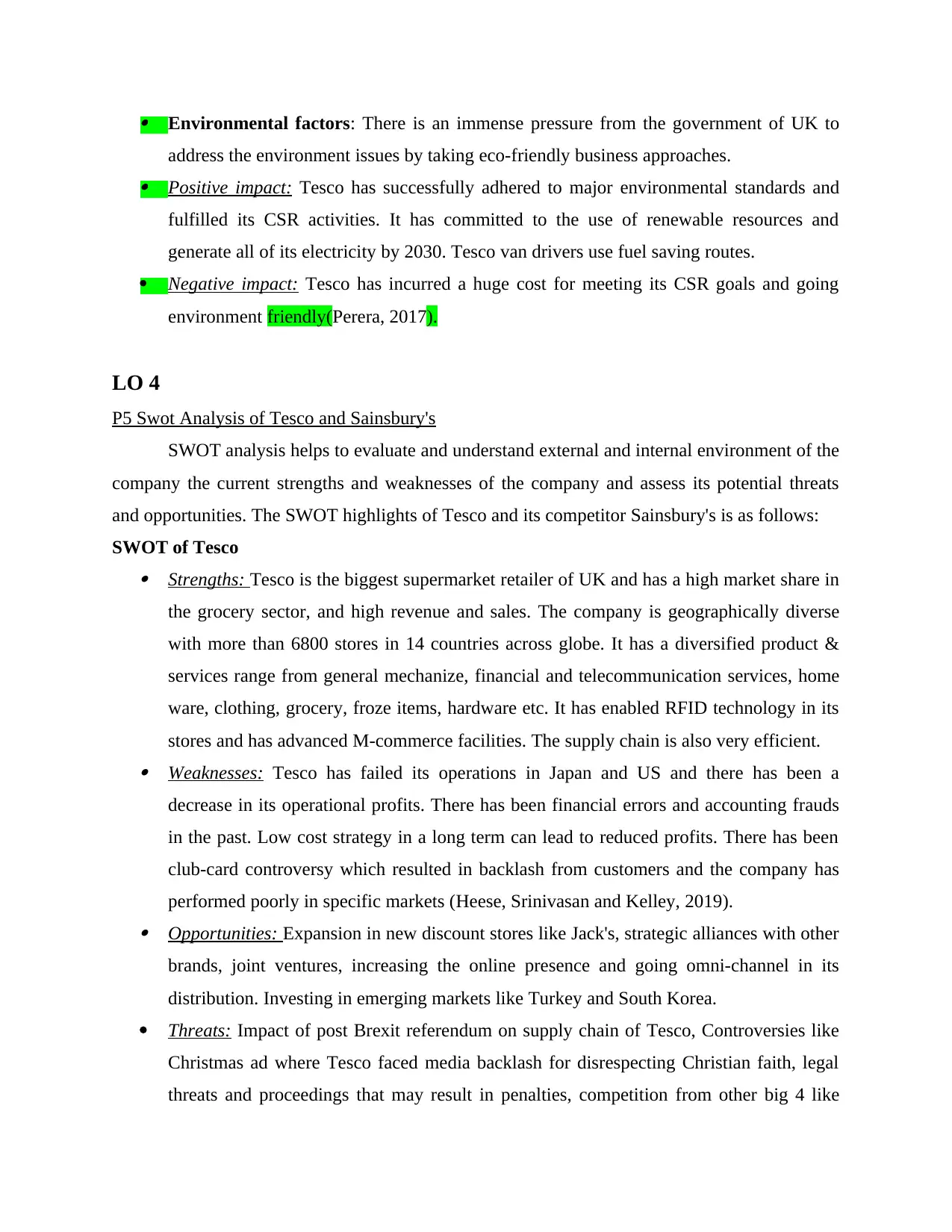
Environmental factors: There is an immense pressure from the government of UK to
address the environment issues by taking eco-friendly business approaches. Positive impact: Tesco has successfully adhered to major environmental standards and
fulfilled its CSR activities. It has committed to the use of renewable resources and
generate all of its electricity by 2030. Tesco van drivers use fuel saving routes.
Negative impact: Tesco has incurred a huge cost for meeting its CSR goals and going
environment friendly(Perera, 2017).
LO 4
P5 Swot Analysis of Tesco and Sainsbury's
SWOT analysis helps to evaluate and understand external and internal environment of the
company the current strengths and weaknesses of the company and assess its potential threats
and opportunities. The SWOT highlights of Tesco and its competitor Sainsbury's is as follows:
SWOT of Tesco Strengths: Tesco is the biggest supermarket retailer of UK and has a high market share in
the grocery sector, and high revenue and sales. The company is geographically diverse
with more than 6800 stores in 14 countries across globe. It has a diversified product &
services range from general mechanize, financial and telecommunication services, home
ware, clothing, grocery, froze items, hardware etc. It has enabled RFID technology in its
stores and has advanced M-commerce facilities. The supply chain is also very efficient. Weaknesses: Tesco has failed its operations in Japan and US and there has been a
decrease in its operational profits. There has been financial errors and accounting frauds
in the past. Low cost strategy in a long term can lead to reduced profits. There has been
club-card controversy which resulted in backlash from customers and the company has
performed poorly in specific markets (Heese, Srinivasan and Kelley, 2019). Opportunities: Expansion in new discount stores like Jack's, strategic alliances with other
brands, joint ventures, increasing the online presence and going omni-channel in its
distribution. Investing in emerging markets like Turkey and South Korea.
Threats: Impact of post Brexit referendum on supply chain of Tesco, Controversies like
Christmas ad where Tesco faced media backlash for disrespecting Christian faith, legal
threats and proceedings that may result in penalties, competition from other big 4 like
address the environment issues by taking eco-friendly business approaches. Positive impact: Tesco has successfully adhered to major environmental standards and
fulfilled its CSR activities. It has committed to the use of renewable resources and
generate all of its electricity by 2030. Tesco van drivers use fuel saving routes.
Negative impact: Tesco has incurred a huge cost for meeting its CSR goals and going
environment friendly(Perera, 2017).
LO 4
P5 Swot Analysis of Tesco and Sainsbury's
SWOT analysis helps to evaluate and understand external and internal environment of the
company the current strengths and weaknesses of the company and assess its potential threats
and opportunities. The SWOT highlights of Tesco and its competitor Sainsbury's is as follows:
SWOT of Tesco Strengths: Tesco is the biggest supermarket retailer of UK and has a high market share in
the grocery sector, and high revenue and sales. The company is geographically diverse
with more than 6800 stores in 14 countries across globe. It has a diversified product &
services range from general mechanize, financial and telecommunication services, home
ware, clothing, grocery, froze items, hardware etc. It has enabled RFID technology in its
stores and has advanced M-commerce facilities. The supply chain is also very efficient. Weaknesses: Tesco has failed its operations in Japan and US and there has been a
decrease in its operational profits. There has been financial errors and accounting frauds
in the past. Low cost strategy in a long term can lead to reduced profits. There has been
club-card controversy which resulted in backlash from customers and the company has
performed poorly in specific markets (Heese, Srinivasan and Kelley, 2019). Opportunities: Expansion in new discount stores like Jack's, strategic alliances with other
brands, joint ventures, increasing the online presence and going omni-channel in its
distribution. Investing in emerging markets like Turkey and South Korea.
Threats: Impact of post Brexit referendum on supply chain of Tesco, Controversies like
Christmas ad where Tesco faced media backlash for disrespecting Christian faith, legal
threats and proceedings that may result in penalties, competition from other big 4 like
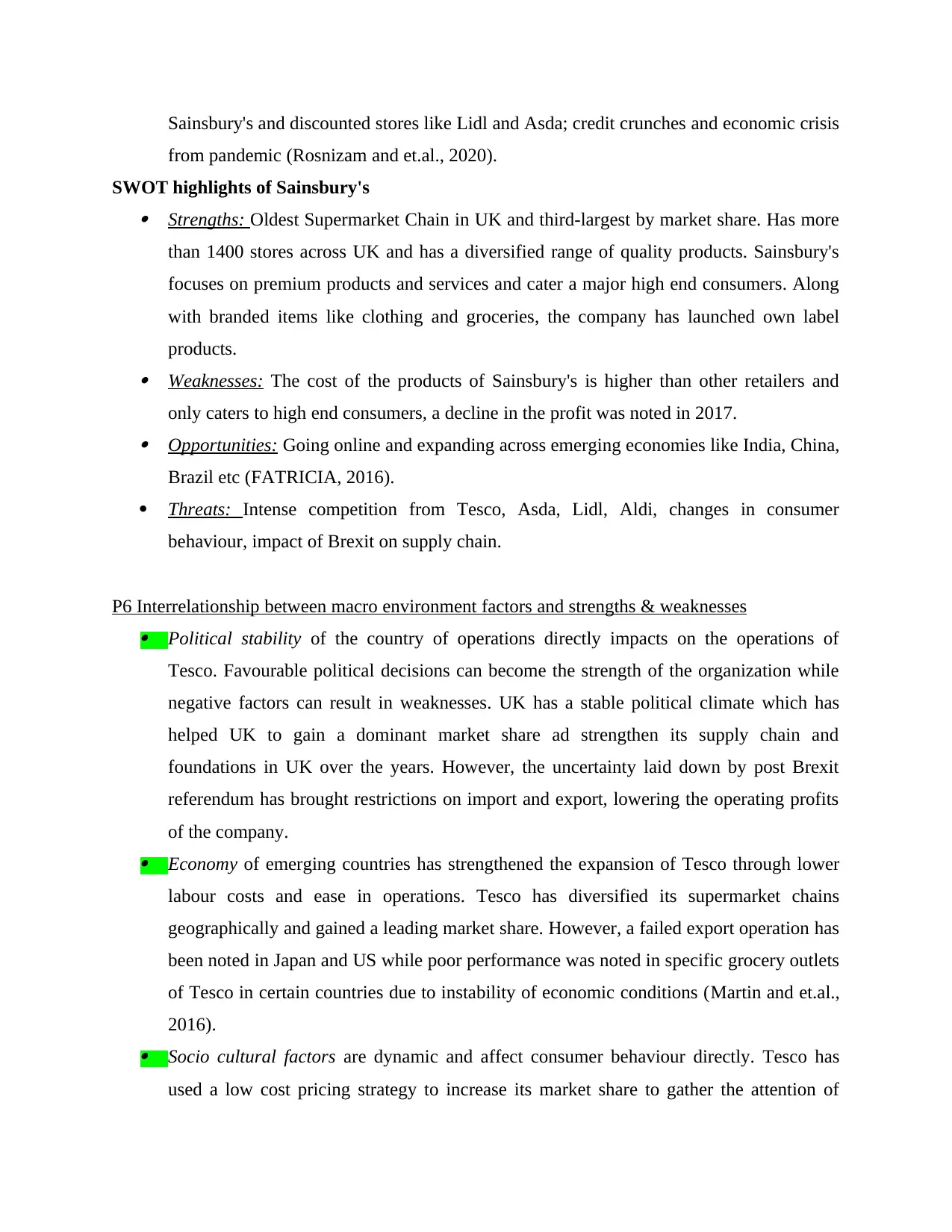
Sainsbury's and discounted stores like Lidl and Asda; credit crunches and economic crisis
from pandemic (Rosnizam and et.al., 2020).
SWOT highlights of Sainsbury's Strengths: Oldest Supermarket Chain in UK and third-largest by market share. Has more
than 1400 stores across UK and has a diversified range of quality products. Sainsbury's
focuses on premium products and services and cater a major high end consumers. Along
with branded items like clothing and groceries, the company has launched own label
products. Weaknesses: The cost of the products of Sainsbury's is higher than other retailers and
only caters to high end consumers, a decline in the profit was noted in 2017. Opportunities: Going online and expanding across emerging economies like India, China,
Brazil etc (FATRICIA, 2016).
Threats: Intense competition from Tesco, Asda, Lidl, Aldi, changes in consumer
behaviour, impact of Brexit on supply chain.
P6 Interrelationship between macro environment factors and strengths & weaknesses Political stability of the country of operations directly impacts on the operations of
Tesco. Favourable political decisions can become the strength of the organization while
negative factors can result in weaknesses. UK has a stable political climate which has
helped UK to gain a dominant market share ad strengthen its supply chain and
foundations in UK over the years. However, the uncertainty laid down by post Brexit
referendum has brought restrictions on import and export, lowering the operating profits
of the company. Economy of emerging countries has strengthened the expansion of Tesco through lower
labour costs and ease in operations. Tesco has diversified its supermarket chains
geographically and gained a leading market share. However, a failed export operation has
been noted in Japan and US while poor performance was noted in specific grocery outlets
of Tesco in certain countries due to instability of economic conditions (Martin and et.al.,
2016). Socio cultural factors are dynamic and affect consumer behaviour directly. Tesco has
used a low cost pricing strategy to increase its market share to gather the attention of
from pandemic (Rosnizam and et.al., 2020).
SWOT highlights of Sainsbury's Strengths: Oldest Supermarket Chain in UK and third-largest by market share. Has more
than 1400 stores across UK and has a diversified range of quality products. Sainsbury's
focuses on premium products and services and cater a major high end consumers. Along
with branded items like clothing and groceries, the company has launched own label
products. Weaknesses: The cost of the products of Sainsbury's is higher than other retailers and
only caters to high end consumers, a decline in the profit was noted in 2017. Opportunities: Going online and expanding across emerging economies like India, China,
Brazil etc (FATRICIA, 2016).
Threats: Intense competition from Tesco, Asda, Lidl, Aldi, changes in consumer
behaviour, impact of Brexit on supply chain.
P6 Interrelationship between macro environment factors and strengths & weaknesses Political stability of the country of operations directly impacts on the operations of
Tesco. Favourable political decisions can become the strength of the organization while
negative factors can result in weaknesses. UK has a stable political climate which has
helped UK to gain a dominant market share ad strengthen its supply chain and
foundations in UK over the years. However, the uncertainty laid down by post Brexit
referendum has brought restrictions on import and export, lowering the operating profits
of the company. Economy of emerging countries has strengthened the expansion of Tesco through lower
labour costs and ease in operations. Tesco has diversified its supermarket chains
geographically and gained a leading market share. However, a failed export operation has
been noted in Japan and US while poor performance was noted in specific grocery outlets
of Tesco in certain countries due to instability of economic conditions (Martin and et.al.,
2016). Socio cultural factors are dynamic and affect consumer behaviour directly. Tesco has
used a low cost pricing strategy to increase its market share to gather the attention of
⊘ This is a preview!⊘
Do you want full access?
Subscribe today to unlock all pages.

Trusted by 1+ million students worldwide
1 out of 14
Related Documents
Your All-in-One AI-Powered Toolkit for Academic Success.
+13062052269
info@desklib.com
Available 24*7 on WhatsApp / Email
![[object Object]](/_next/static/media/star-bottom.7253800d.svg)
Unlock your academic potential
Copyright © 2020–2025 A2Z Services. All Rights Reserved. Developed and managed by ZUCOL.




